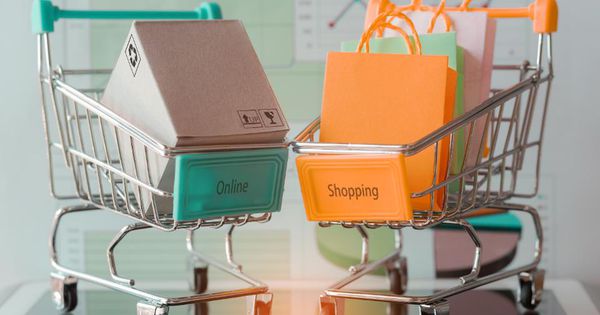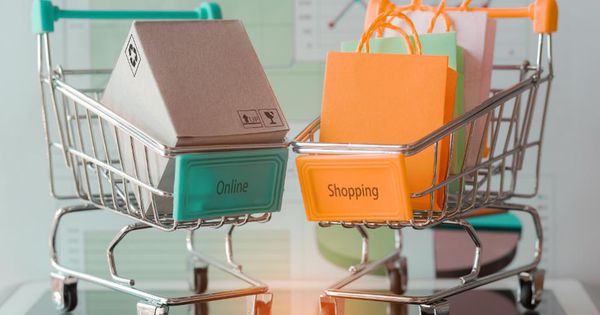
Cardboard box and Colourful paper bags in trolley on laptop keyboard with chart background. Consumers can buy products directly from seller over internet. Online shopping and e-commerce concept.Getty
The year 2018 is coming to a close. Love it or hate it, 2018 will likely go down as another year when we said goodbye to a few age-old brands and retailers while simultaneously welcoming the emergence of new brands shaped to suit the continually-evolving expectations of the modern shopper. Here are 5 things we learned this year:
Reports of the ‘death of retail’ were greatly exaggerated.
Doomsayers predicting the death of retail thanks to Amazon may have jumped the gun. Even while the numbers of store closures set a record last year, a recent New York Times article said it best when it noted that Amazon may indeed be the driving force behind why retail will succeed. This year, we’ve seen traditional retailers taking pages from Amazon to create better experiences for customers, luring them back in-store. “The retailers that get it recognize that Amazon has forever changed consumer behavior,” said article author Barbara Kahn, a marketing professor and former director of the retailing center at the Wharton School. “I shouldn’t have to work to shop.”We’re seeing retailers embracing concepts including curb-side pickup, in-store personal shoppers, interactive touch screens and cashier-less checkouts to simplify experiences. Some retailers are also using their physical footprint to offer fun and engaging experiences in-store with technologies like “smart” dressing room mirrors, augmented reality and personalized push notifications to their phones for promotions and discounts.
Power shifted from retailers to brands.
Consumers are looking for great products and great brands, and the channel through which they buy them became less relevant in 2018. Further, with the barriers to entry ever lower, we saw the emergence of many new brands which set up websites and started selling almost immediately. This powered a shift in the age-old model where department stores and retailers had been able to decide which brands and products to carry. Further exacerbating the power struggle was the maturation of new brands like Allbirds, Everlane, and Bonobos encroaching on physical retail by launching their own physical stores. Retailers fought back and we’re seeing more retailers like Walmart and Amazon trying to compete by acquiring and launching their own private label brands.
AI and Machine Learning crossed the chasm from buzzworthy to big money.
Powered by big data, what was once a “nice-to-have” became a must-have in 2018. Deborah Weinswig wrote a great piece earlier this year which discussed how AI is helping retailers process enormous amounts of data, typically from multiple sources, to identify opportunities and solutions. AI, along with machine learning, are now finally solving “age-old problems such as inaccurate inventory, stockouts and overstocks, overstretched and undertrained store associates, and suboptimal pricing.” New research confirms growing retail investments in AI, predicting that application of AI technologies in the retail market will exceed $8 billion by 2024, as retailers use AI to personalize in-store and online shopping experiences and ensure they are bringing the right products to market at the right price points.
Millennial purchasing power continues to grow; retailers are all focused on how to sell to them.
This year, retailers and brands wanting to win the hearts of thrifty millennials learned a few hard lessons. While this generation of shopper may have a growing wallet on paper, it doesn’t mean they’re big spenders. A heavier debt burden, higher bills, and a minimalist view of the world means they’re very picky purchasers. Further, their affinity for quality at reasonable prices and socially conscious brands means that to target millennials, retailers and brands need to connect in a personal way with these shoppers while not losing focus on Xers and Boomers.
Retailers say they want to be “customer-centric” but are still figuring out how to do it in practice.
Retailers now know that putting the customer at the center of their business strategy is critical. But they don’t know how to do this in a way that drives actionable decisions – with speed and at scale.
In 2018, the customer-centric model was truly tested. Traditional retailers who were still telling consumers what they should like, rather than following their voice to offer the right products, prices and shopping experiences fell hard. Think Sears, Toys R Us, Nine West and Claire’s. Despite all the hype, customer-centric businesses still struggled to change their strategies, with the biggest hurdle for most retailers coming from within.I came across this Retail Dive article from earlier this year by James Damian, former senior vice president and chief design officer of the Experience Design Group at Best Buy, which explains how customer-centricity isn’t just a box to be checked off, and often fails because retailers “ignore the power of the culture and its gravitational pull to fight change.”
When we entered 2018, skepticism was high on whether traditional retailers would be able to evolve to meet the changing expectations of consumers. 2018 proved to be a tipping point for many in the industry, as they adopted emerging technologies like AI, began to better understand how to keep pace with the connected consumer thanks to big data. The “new normal” in retail may well be a constant state of change. And as more retail companies align their businesses to facilitate customer-centric models, we believe we’ll continue to see further evolution in retail. In fact, we believe that this retail evolution is only just starting.

